Guidelines for the Control of Legionella in Manufactured Water ...
Guidelines for the Control of Legionella in Manufactured Water ...
Guidelines for the Control of Legionella in Manufactured Water ...
You also want an ePaper? Increase the reach of your titles
YUMPU automatically turns print PDFs into web optimized ePapers that Google loves.
Schedule 3<br />
Schedule 3<br />
Procedures <strong>for</strong> decontam<strong>in</strong>ation <strong>of</strong> cool<strong>in</strong>g water systems and hot water<br />
and warm water systems<br />
Part 1 – procedure <strong>for</strong> <strong>of</strong>f-l<strong>in</strong>e decontam<strong>in</strong>ation <strong>of</strong> cool<strong>in</strong>g water systems<br />
BEFORE COMMENCING THE PROCEDURE: ensure that <strong>the</strong> operator is protected from exposure to hazardous<br />
substances and aerosols accord<strong>in</strong>g to relevant work health and safety legislation. A suitable face mask with a<br />
particulate filter <strong>of</strong> at least Class P2 that complies with AS/NZS 1716 should be worn. Additional PPE may also<br />
<strong>in</strong>clude gloves, hardhat, and protective cloth<strong>in</strong>g. Appendix A <strong>of</strong> AS/NZS 3666.2 has fur<strong>the</strong>r details relat<strong>in</strong>g to<br />
specific tasks and appropriate PPE<br />
1. Shut down <strong>the</strong> system.<br />
2. Isolate cool<strong>in</strong>g tower fans to prevent operation.<br />
3. Circulate a dispersant throughout <strong>the</strong> system.<br />
4. Dose with sodium hypochlorite and circulate to ma<strong>in</strong>ta<strong>in</strong> a free chlor<strong>in</strong>e residual <strong>of</strong> 5–10 mg/L at pH 7.0–7.6,<br />
ma<strong>in</strong>ta<strong>in</strong> <strong>the</strong>se concentrations and monitor at 15 m<strong>in</strong>ute <strong>in</strong>tervals <strong>for</strong> at least 60 m<strong>in</strong>utes.<br />
5. Isolate <strong>the</strong> system and dra<strong>in</strong> water to a sewer or trade waste <strong>in</strong> accordance with <strong>the</strong> requirements <strong>of</strong> <strong>the</strong><br />
appropriate relevant regulatory authority, ensur<strong>in</strong>g that any isolated pipe work such as bypass pipes and<br />
secondary pumps are also dra<strong>in</strong>ed.<br />
6. Open all system dra<strong>in</strong>s temporarily to flush dra<strong>in</strong> l<strong>in</strong>es with dis<strong>in</strong>fected water.<br />
7. Clean all wetted surfaces <strong>in</strong> accordance with <strong>the</strong> manufacturer’s <strong>in</strong>structions or by us<strong>in</strong>g water spray and<br />
mechanical clean<strong>in</strong>g as necessary. Exercise care to avoid damag<strong>in</strong>g components.<br />
8. Refill <strong>the</strong> system.<br />
9. Dose <strong>the</strong> circulat<strong>in</strong>g cool<strong>in</strong>g water with sodium hypochlorite to ma<strong>in</strong>ta<strong>in</strong> a free chlor<strong>in</strong>e residual <strong>of</strong> 1–5 mg/L<br />
at pH 7.0–7.6 and monitor <strong>the</strong> concentrations at 15 m<strong>in</strong>ute <strong>in</strong>tervals <strong>for</strong> at least 30 m<strong>in</strong>utes.<br />
10. Dra<strong>in</strong> <strong>the</strong> system, refill, re<strong>in</strong>state water treatment programs and recommission.<br />
NOTE: Wastewater must not be discharged to stormwater, surface waters (such as rivers, streams, wetlands or lakes)<br />
or underground waters. It may be disposed to a sewer or community wastewater management scheme, but not to a<br />
septic tank unless it can be demonstrated to <strong>the</strong> relevant authority that <strong>the</strong> biocide concentrations or <strong>the</strong> quantity or<br />
hydraulic flow will not have adverse impacts on <strong>the</strong> operation <strong>of</strong> <strong>the</strong> septic tank. Approval <strong>for</strong> discharge <strong>in</strong>to a sewer or<br />
community wastewater management scheme needs to be obta<strong>in</strong>ed from <strong>the</strong> appropriate authority which may be <strong>the</strong><br />
local council, SA <strong>Water</strong>, SA Health or <strong>the</strong> Environment Protection Authority. Any cool<strong>in</strong>g water discharged to sewer must<br />
comply with <strong>the</strong> SA <strong>Water</strong> Cool<strong>in</strong>g <strong>Water</strong> Discharge Trade Waste Guidel<strong>in</strong>e.<br />
<strong>Guidel<strong>in</strong>es</strong> <strong>for</strong> <strong>the</strong> <strong>Control</strong> <strong>of</strong> <strong>Legionella</strong> <strong>in</strong> <strong>Manufactured</strong> <strong>Water</strong> Systems <strong>in</strong> South Australia page 27

















